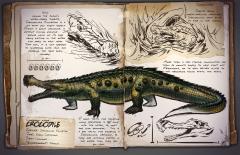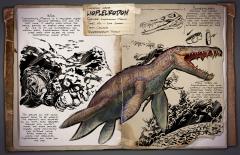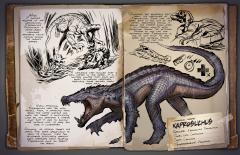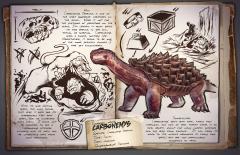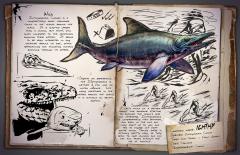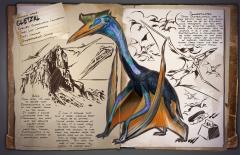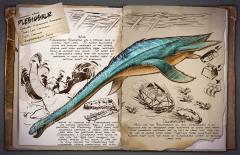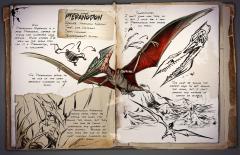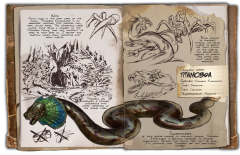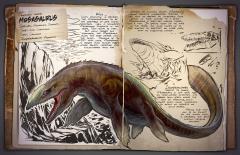Search the Community
Showing results for tags 'reptile'.
-
Art once again done by the amazingly talented Riskybiscuits Species: Shastasaurus Sikanniensis Time: Middle-Late Triassic Diet: Carnivore Temperament: Passive Wild The Shastasaurus is one of the largest ocean dwellers I have ever witnessed on any of the Arks rivalling the Leedsycthis in terms of sheer mass and being too large for even the mighty tusotuthis to grab a hold of. However, despite its titanic size it is incredibly passive mostly ignoring all other creatures in its vicinity as very few are a threat to it with it only really focusing on smaller schools of fish which it feeds on. If a threat does arrive though such as a group of Mosasaurs or a Leedsycthis it has the special ability of echolocation and is able to detect the threat coming from a mile away. Not just that but it’s echolocation is so powerful that it can charge a large sonic blast with it being able to disorient nearly any hostile allowing the creature to make a quick getaway. Also, much like it’s close relative the ichthyosaurus it is a very social animal living in a tight family unit however due to the sheer size of the Shasta's appetite each member requires an enormous quantity of food and as a result the family units must separate to try and find food on their own to avoid competing for food sources. Sadly, due to the family units splitting up to feed many shastas will never reunite with them and will become incredibly isolated as a result. Domesticated As most Shastasaurus have become isolated and alone due to separating from their families all it requires to domesticate one is simple companionship the best way I have found to do this is with it’s close relative the Ichthyosaurus simply bring a group of them over and the 2 species will begin to interact with the Shastasaurus eventually joining the group and therefore your tribe. Once tamed the Shastasaurus makes for an incredible beast of burden able to carry an insane amount of weight due to this a lot of survivors have constructed a special saddle on the back of the creature this saddle is essentially a submarine as anyone inside it is able to breath and survive the intense pressure of the deep ocean. The saddle also comes equipped with Torpedoes that are essential for any underwater combat as they deal heavy explosive damage. And that’s not even the best part of the saddle when the shastasaurus surfaces above the water the saddle will transform and essentially turn the Shastasaurus into a whaling ship coming equipped with Harpoon launchers these harpoons come equipped with Metal wiring that is attached to each harpoon once fired at a creature it prevents them from moving allowing survivors to easily catch creatures. Abilities and features ·When underwater Saddle acts as a submarine survivors will not lose oxygen and will be able to build in it ·Saddle fires torpedoes these are underwater specific projectiles that deal heavy explosive damage upon impact and they can only be crafted in the inventory of the Shasta (similar to the Equus) ·When the Shasta surfaces the saddle transforms into a whaling ship where the submarine dome disappears and opens up to reveal Harpoon guns these guns are manned turrets that come equipped with metal wiring attached to each harpoon and when fired at an enemy creature it prevents them from moving and essentially binds them this can also be done on enemy players and land creatures and if a creature is small enough you are able to reel them in closer even larger creatures can be reeled in if enough Harpoon guns are fired on it. However the guns have their weaknesses to compensate firstly a creature or enemy player can break out of the Harpoon if they struggle enough (similar to the desmodus or Bloodstalker) and the Harpoon turrets have a durability meter and after a while will require repairs ·Saddle also comes equipped with a Submarine scope allowing you to view the surface of the water while submerged it also acts as a magnifying glass and shows the current health and torpidity of a creature ·Cannot be grabbed by a Tuso due to it’s sheer size ·Has echolocation this essentially gives the Shasta a built in submarine radar allowing it to detect any hostile creatures or players in the immediate area and Highlights everything nearby ·Can charge up a sonic blast with it’s echolocation when fired it disorients enemies essentially acting as a flashbang grenade and enabling the shasta to make an escape if the fight looks to be unwinnable this blast also can disable tek structures and gear including tek underwater bases ·Is very efficient at gathering oil from underwater oil veins and gathers Black pearls effectively from eurypterids and other creatures that drop them ·Saddle is similar to the andrewsarchus saddle as it doesn't require anything to power it and will produce oxygen in the submarine mode for no cost ·Shastasaurus can use it's massive tail to create large whirlpools in the water these can trap enemies in them for a short period of time and disorient them ·Can use a type of suction feeding to suck smaller creatures into it's beak and grip hold of them ·If swarmed the shasta can fire off a sonar pulse this will be a concussive explosion of sound coming off the shasta that will push all enemies back when the shasta is being swarmed ·Can only be tamed by bringing a bunch of tamed Ichthyosaurus or other Shastasaurus and putting them on wandering near it this will cause the wild shasta to interact with those tames and slowly begin to integrate into your tribe however if one of it's companions or the shasta itself is hurt the taming effectiveness will decrease and if one of them is killed the shasta will no longer be tameable and If the player attacks one of the shasta's companions or the shasta itself the whole group will become hostile to the player
- 272 replies
-
- 7
-

-

-
The Gilamonster (hilu mon stirr) is a venomous lizard that can be black with orange, yellow, red or peach swirls, spots and stripes. It is about the size of a human forearm and has a short stubby tail. It has a mildly venomous bite that although not very dangerous to humans, is still very painful. When biting a target, it will latch on and lock its mouth closed for about thirteen hours (13 minutes in game) or let go until evening. Gilamonsters have HIGHLY slow metabolisms, so they can go for three months without food (4 Dodo eggs a YEAR) so you dont have to worry about feeding it. Gilamonsters sometimes fight for dominance or to attract a mate, so you don't have to be surprised if you see them fighting each other. Abilities: Burrow. Gilamonsters can burrow underground. [Right mouse button] Bite. [Left mouse button] Latch on and inject venom. [Left mouse button and hold in] Tail whip. [C] Ridable. Can carry two humans. Climb. [Ctrl] Temperament: Docile to humans. Spawn locations: Deserts, Caves. Diet: Carnivore, Insectivore, Arachnivore, Piscivore. Drops when dead: Hide, Meat, Gilamonster venom (can use to make anti-venom), Gilamonster skull (trophy).
-
- gilamonster
- lizard
-
(and 4 more)
Tagged with:
-
Steneosaur the water drifter The Steneosaurus is Very Aggressive and lives in warm waters on the Center, it eats fish and honey, it is very big and you can ride it abilities: the Steneosaurus does not have very stable teeth, but if it bites into a Brontosaurus, for example, its entire teeth will get stuck and cause bleeding and poison damage as much damage as it does with the attack as much life as the steneosaurus, riders and all tamed animals around it get the steneosaurus is extremely fast in the water and, like the manta ray, can make a pike jump out of the water. the more he swims he gets faster and faster when he reaches maximum speed then he can jump so far out of the water that he can do tricks in the air on land it isn't that slow either, as it gallops and can then be about as fast as a sabertooth tiger He can also carry three artifacts He can even if he is completely still in the water then he can also become completely invisible if he is invisible then you only see his eyes at night his eyes also light up his back is made of some kind of metal and you can hardly damage him from above his teeth can grow back in a minute but if you feed him fried fish only 30 seconds but if you feed him fried fish and honey only 15 seconds he can also bury each egg in sand so the egg is protected from enemy players and creatures the egg hatches at twice the speed you don't have to place any torches you just have to go to a warm beach, preferably in the jungle tame: to tame him you have to bring him a wild animal (para-bronto) and then when his charged bite attack makes and his teeth are stuck in the animal then you have to bring his life to 20% and then you can feed him narco berries size:
-
From the album: Dossiers
Common Name: Sarco Species: Sarcosuchus excubitor Time: Early Cretaceous Diet: Carnivore Temperament: Patient Wild: Among the island's water-based threats, Sarcosuchus excubitor is a lot what you might expect from a giant crocodile: A patient killing machine. It spends much of its days lazily waiting in the water for prey to walk near. That said, it is not opposed to scurrying onto land and pressing the issue when hungry. A good tactic for escaping many predators is to jump into the water, as most are slow swimmers. This is a bad tactic for escaping a Sarcosuchus, obviously, as they are actually faster in the water than they are on land. Domesticated: Despite being river-dwelling creatures, Sarcosuchus seem quite at ease in the oceans. More than a few fishing communities use them as mounts simply to help fight off Megalodons, or to gain better access to the resources found within the reefs. -
From the album: Dossiers
Common Name: Liopleurodon Species: Liopleurodon Magicus Time: Mid-Late Jurassic Diet: Carnivore Temperament: Patient Wild: Liopleurodon Magicus is a mid-sized ocean predator. Typically between 20 and 25 feet long, it mostly hides within the reefs, waiting to ambush prey that swims by. Due to its low acceleration and medium speed, Liopleurodon tends not to chase prey that escape its initial devastating chomp attack. The species on the island almost seems, to be magical. The reptiles skin secretes an oil that, when absorbed through skin contact, makes the rider process oxygen more efficiently for extreme diving. When traveling the ocean for resources Liopleurodon will show you the way. Domesticated: Neither the fastest swimmer, nor the most powerful ocean predator, Liopleurodon still has its uses for those wanting to stay underwater for extended periods of time. Many tribes use Liopleurodon for long duration oil-and-oyster harvesting trips. Often, those who don't believe in the Liopleurodons qualities are shunned.- 1 comment
-
- liopleurodon
- water
- (and 7 more)
-
From the album: Dossiers
Common Name: Kaprosuchus Species: Kaprosuchus Paludentium Time: Late Cretaceous Diet: Carnivore Temperament: Aggressive Wild: A smaller relative of the Sarcosuchus, Kaprosuchus Paludentium is water-based carnivore primarily found lurking among The Island's swamps. A naturally fast runner that is even faster in the water, it is a solitary hunter that picks off small-to-medium creatures especially those isolated from their pack. When attacking Kaprosuchus uses two main tactics. First, it patiently waits below the water surface and when the target is sufficiently close by, will perform a lateral jump that it uses to quickly close the distance with its prey and drag it underwater. Secondly, its attacks target the prey's vital areas specifically to drain its stamina. These two techniques effectively prevent most creatures from escaping Kaprosuchus once an assault has begun. Domesticated: Survivors are generally split about the usefulness of Kaprosuchus. Some love its speed both in and out of the water, essentially making it among the fastest small-sized all-terrain mounts when travelling through the wetlands. Others do not like how relatively frail Kaprosuchus is, and do not think its high speed and damaging attacks make up for this shortcoming.- 1 comment
-
- kaprosuchus
- late cretaceous
-
(and 6 more)
Tagged with:
-
From the album: Dossiers
Common Name: Carbonemys Species: Carbonemys obibimus Time: Danian Diet: Herbivore Temperament: Defensive Wild: Carbonemys obibimus is one of the least aggressive creatures on the island. Were it not for the plethora of predators on the island, I'm certain it would spend its days basking in the sun, eating, or sleeping. Carbonemys leads a simple, solitary life. It seems to be one of the most peaceful animals I have yet encountered. With its slow walking speed, the only things that keep it safe are its surprisingly fast swim speed, and its incredibly thick shell. I would not be surprised to see a Carbonemys withdraw entirely into its shell and be completely safe from most predators. Domesticated: Carbonemys ' swift swim rate, fairly high strength, and lack of real threat makes it an ideal aquatic mount for many coastal survivors who shy away from violence. It can carry its rider to the ocean's resources at a fairly high speed, and are not particularly dangerous to tame.-
- carbonemys
- turtle
- (and 6 more)
-
From the album: Dossiers
Common Name: Dimorphodon Species: Dimorphodon equesica Time: Early Jurassic Diet: Carnivore Temperament: Reactive Wild: Dimorphodon Equesica is another of the island's Jekyll-and-Hyde creatures. It is normally passive, sometimes even friendly. When provoked, it becomes very aggressive, even against larger creatures it has no business fighting... often to its own fatal end. Dimorphodon can make short work of smaller opponents, however, due to its large (but lightweight) skull and teeth. Barely a meter tall, Dimorphodon should be low on the food chain, but its incredible speed and surprisingly strong bite makes it fairly dangerous, especially en masse as they tend to attack in groups. A flock of angry or hungry Dimorphodon can take down prey several times their size, so survivors should take care not to hunt near where a flock is gathered. Domesticated: Dimorphodon is one of the creatures on the island that is easily domesticated for companionship. But its use in combat is also quite clear: it will hunt in large groups to seek out enemy dino riders directly, harassing them to no end—regardless of the might of the mount upon they may be astride!-
- dimorphodon
- dimo
- (and 8 more)
-
From the album: Dossiers
Common Name: Ichthy Species: Ichthyosaurus curiosa Time: Late Triassic - Early Jurassic Diet: Carnivore Temperament: Curious Wild: Ichthyosaurus curiosa is a comparatively small carnivore found in the waters around the island. It is slightly larger than a human, but that’s still small compared to the leviathans roaming these waters. It seems to be very interested in any creature around its size, often approaching and following humans swimming through its waters. Despite its appearance, the Ichthyosaurus is neither a fish nor an ocean mammal. Like many creatures in the waters around the island, it is actually an aquatic reptile. Domesticated: I can’t think of a better mount for someone starting to explore the island’s seas and waterways. Ichthyosaurus is comparatively fast swimmer, and even in the wild will cozy right up to you and try to figure out what you’re doing. Taming these is actually pretty easy, as they seem to love humans and will be fed and tamed without the use of violence.-
- ichthy
- ichthyosaurus
- (and 10 more)
-
From the album: Dossiers
Common Name: Quetzal Species: Quetzalcoatlus conchapicem Time: Late Cretaceous Period Diet: Carnivore Temperament: Skittish Wild: Quetzalcoatlus is one of the largest avians on the island. It shares a similar silhouette with the Pteranodon, and nests near the absolute highest peaks. Upon closer inspection, though, Quetzalcoatlus is an enormous creature of tremendous power. I find it strange that such a large, imposing beast would be so skittish. Unlike other creatures of its size, it is more likely to flee than fight. I suppose the decision to flee from any trouble keeps the species alive on an island with so many dangerous predators. But then how does it eat enough to sustain its massive size? Domesticated: Tamed Quetzalcoatlus have a very specific role on the island. Too slow to be an efficient local transport, and too weak to be an effective warbird, the tribes I have encountered tend to employ it as a mass carrier.Quetzalcoatlus is primarily used by these masters of the skies to safely carry vast quantities of supplies, creatures and human cargo from one base to another without tiring. -
From the album: Dossiers
Common Name: Plesiosaur Species: Elasmosaurus remuspissa Time: Late Cretaceous Diet: Carnivore Temperament: Docile Wild: Elasmosaurus remuspissa has a strange role in the oceanic food chain. It almost exclusively hunts the smaller creatures in the waters, leaving most even moderately large creatures (such as humans) alone. The sheer size of theElasmosaurus means that the quantity of creatures it must eat to sustain itself is nothing short of enormous. Despite its imposing size, Elasmosaurus still has natural predators. Well, a natural predator: the Megalodon. Apart from that monstrous creature, I myself have only ever seen two creatures bring down an Elasmosaurus: a Spinosaurus that found its way into the deeps (not common), and humans. Though I will admit, I have yet to fully explore the staggering deep underwater caverns surrounding the island. Domesticated: Much like the Brontosaurus on land, Elasmosaurus is an excellent way to transport large quantities of goods over water. These powerful creatures are in fact so large that they can be used as mobile water bases. Ambitious tribes sometimes build bunkers right onto the backs of Elasmosaurus instead of building cargo ships. -
From the album: Dossiers
Common Name: Pteranodon Species: Pteranodon wyvernus Time: Late Cretaceous Diet: Carnivore Temperament: Skittish Wild: Pteranodon wyvernus is a large pterosaur, capable of flying for incredibly long periods. While others I've seen on the island still call it a Pterodactyl, this is inaccurate. The Pteranodon seems to be one of the least aberrant Reptile on the island. Pteranodon wyvernus mostly feeds itself by eating the small fish around the island, but they can also be found scavenging any number of dead animals. Because of this they are one of the most common Creatures on the island. Domesticated: I don't know how they did it, but I once saw a trio of Pteranodons with riders on them. This must be the fastest way to get around the island, but it can't provide any measure of safety or secrecy. -
From the album: Dossiers
Common Name: Titanoboa Species: Titanoboa exornantur Time: Paleocene Diet: Carnivore Temperament: Aggressive Wild: Found in the swamps and the dark caves of the island, Titanoboa exornantur is an aggressive creature that prefers cold dark rocky areas. This extremely large snake, while being a member of theTitanoboa family, does not constrict its prey as most boas do. This adaption may come from coexisting with giant insects. Being immune to knockout poisons, and being unable to pierce the thick chitin of the insects, the species have learned to coexist. They often even hunt large prey together. Titanoboahas developed a strange coexistence with the other creatures of the island's caves. Domesticated: As they appear immune to knockout poisons, Titanoboa exornantur is basically impossible to render unconscious. Because this crucial step can't be done, taming this can be a challenge! -
From the album: Dossiers
Common Name: Mosasaurus Species: Mosasaurus suspirita Time: Late Cretaceous Diet: Carnivore Temperament: Aggressive Wild: Until recently, I believed the Ultramegalodon to be the greatest of the ocean predators. Then I discovered Mosasaurus suspirita in the deeps. Not quite as fast, but much larger and stronger, the Mosasaurus rules the deep waters off the island. Growing up to 50 feet long, Mosasaurus is larger than almost every other aquatic creature I've encountered thus far. Contrary to common belief, Mosasaurus cannot breathe underwater. Rather, it can hold its breath an incredibly long period of time, similar to a whale. Mosasaurus is a deep-sea marine lizard, not a fish. It spends most of its time in the deeps, and only comes up to surface to breathe, or chase prey with an engulfing chomp. Domesticated: Despite its power, Mosasaurus is not ideal for all deep-water activities. Its slower swim speed makes the risk of drowning much higher when using Tylosaurus to reach oil deposits or silica pearls. Having one with you as an escort, on the other hand, is probably the best oceanic defense available!-
- mosasaurus
- mosa
- (and 8 more)

.thumb.png.a76eb528c3699ea3f5f9578d9d91c300.png)

